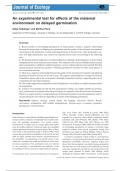Journal of Ecology 2010, 98, 1216–1223 doi: 10.1111/j.1365-2745.2010.01682.x
An experimental test for effects of the maternal
environment on delayed germination
Katja Tielbörger* and Martina Petrů
Department of Plant Ecology, University of Tübingen, Auf der Morgenstelle 3, D-72076 Tübingen, Germany
Summary
1. Recent models on bet-hedging germination in annual plants assume a negative relationship
between the proportion of offspring that germinate and the quality of the maternal environment.
An increase in the proportion of seeds remaining dormant in the next year, when produced in sea-
sons with high reproduction may result from selection that avoids overcrowding in the following
year.
2. We present the first empirical test of this prediction by utilizing a field experiment in Israel which
manipulated the entire maternal environment. We subjected semi-arid and Mediterranean annual
plant communities to different rainfall treatments: control, reduced and increased rainfall. We then
related maternal environment quality to offspring germination fractions for three focal species in
two consecutive seasons.
3. There was a negative relationship between the quality of the maternal environment and offspring
germination fraction in four out of twelve cases. The negative relationship was stronger for the least
competitive species and in the environment with high competition intensity, supporting the role of
competition for the observed pattern.
4. Our results suggest that competition with all neighbours is more likely to explain the pattern than
sib competition.
5. Synthesis. Our findings provide the first experimental evidence of a highly reliable cue (produc-
tivity of maternal environment) that allows for plants to respond to their future biotic environment.
There is an urgent need for testing predictions of theoretical models in natural populations and for
incorporating the role of density dependence in studies of bet-hedging germination.
Key-words: adaptive strategy, annual plants, bet hedging, Biscutella didyma, Bromus
fasciculatus, competition, field rainfall manipulations, Hymenocarpos circinnatus, predictive
germination, seed dormancy
tion’ sensu Cohen 1967; Venable & Lawlor 1980; Ellner
Introduction
1985a). Secondly, Cohen’s density-independent case was
Seed dormancy in annual plants inhabiting unpredictable envi- expanded to a situation, where sibling competition reduces
ronments allows avoidance of temporally unfavourable condi- individual seed yield (Westoby 1981; Bulmer 1984; Ellner
tions. By spreading germination over several seasons, 1985a,b; Léon 1985; Ellner 1986, 1987; Nilsson et al. 1994;
extinction risk is reduced and, on average, plants may exploit Kobayashi & Yamamura 2000). While the number of models
more favourable conditions. Numerous studies have modelled on bet-hedging germination of annuals is extremely large,
optimal germination fractions of annual plants. Most of these empirical evidence from natural populations testing their
were based on the pioneering model of Cohen (1966), which predictions has lagged far behind (Philippi 1993a,b; Pake &
assumes that germination probabilities of all seeds in the seed Venable 1996; Clauss & Venable 2000; Venable 2007).
bank are equal, constant across seasons, and proportional to A common assumption of these models is a homogeneous
the probability of experiencing a favourable season. Later seed bank, i.e. at a given time all seeds in the soil share the same
studies have extended this model and relaxed two of the most germination probability. However, empirical studies have
restrictive assumptions. First, germination rates were allowed shown that this assumption is unrealistic because germination
to vary according to environmental cues indicative of the fractions may vary with respect to the rainfall history that the
favourability of the next season (so-called ‘predictive germina- seeds have experienced, and with the size and fecundity of the
mother plant (Zammit & Zedler 1990; Philippi 1993b;
*Correspondence author. E-mail: katja.tielboerger@uni-tuebingen.de Tielbörger & Valleriani 2005). Nevertheless, several decades
� 2010 The Authors. Journal compilation � 2010 British Ecological Society
, Maternal environment effects on germination 1217
passed since Cohen’s pioneering model before it was shown rise to a change in germination rate could be related to many
theoretically that heterogeneous seed banks could be selected different aspects of quality in the maternal environment, both
for (Tuljapurkar & Istock 1993; Tielbörger & Valleriani 2005; biotic (e.g. competition) or abiotic (e.g. water, nutrient fluxes)
Valleriani & Tielbörger 2006). Such a pattern may emerge, (Platenkamp & Shaw 1993). Testing models of predictive ger-
when predictive germination is coupled with density-depen- mination with general density dependence rather than with
dent seed yield. In this case, seeds produced in favourable (high sib-competition alone poses a conceptual and methodological
yield) seasons should have lower proportional germination challenge. Although theory provides a very clear prediction,
than seeds produced in unfavourable (low yield) seasons. This large-scale manipulations under field conditions are needed to
can be explained as follows: if dormancy is higher after favour- mimic all possible cues for maternal environmental quality.
able seasons, the offspring may reduce negative effects of This is because, unlike models of sib competition, the cue for
crowding in the following year (Tielbörger & Valleriani 2005; competitive conditions in the following year cannot be related
Valleriani & Tielbörger 2006). to the size and fecundity of the mother plant which may vary
In this context, one must properly distinguish between two with local conditions. Instead, the size and fecundity of all
aspects of ‘crowding’ that can have different evolutionary con- plants in the maternal environment are indicative of the poten-
sequences. Most previous models have focused on crowding tial number of neighbours in the following year. Indeed, earlier
among sibs of the same parent, where higher dormancy studies show that a reliable cue for a productive year may be
increased the fitness of the individual mother plant by reducing closely related to neighbour density or productivity in the pre-
the negative effects of sibling competition (e.g. Bulmer 1984; vious year (Platenkamp & Shaw 1993; Crone 1997). This is
Ellner 1986). A conceptual derivative of these models (the also supported by the idea that if maternal and offspring envi-
so-called sib-competition hypothesis), which assumes a hetero- ronments are similar, maternal environment effects are adap-
geneous seed bank, has been tested empirically. The prediction tive (see review by Galloway 2005).
of this hypothesis, which has received some empirical support Because potential cues for environmental quality are diffi-
in the field (Zammit & Zedler 1990; weak support by Hyatt & cult to separate experimentally, one should ideally manipulate
Evans 1998) and in greenhouse studies (Philippi 1993b), is the entire plant community in the field. Here, we were able to
that seeds of mother plants with many seeds exhibit higher utilize a field experiment in two different climatic regions,
dormancy than seeds from small seed families. where annual rainfall has been manipulated to test whether
Another aspect of crowding includes competition among all (prospective) general competition is important in determining
plants (intraspecific and interspecific) in a community. Because offspring germination. It is important to demonstrate the exis-
plants use essentially the same resources and because most tence of such a relationship, because this may indicate a simple
neighbours are non-sibs and interspecific neighbours rather but effective mechanism by which seeds can partly ‘predict’ the
than sibs alone, overall community (diffuse) competition future quality of their environment despite its apparently
should be much more important than sib competition. Also, unpredictable character.
the negative consequence of this type of crowding is effective In this study, we present the first experimental test for such a
not only at an individual level. It also reduces average individ- mechanism. To test for the generality of maternal environment
ual fitness in a population and therefore also reduces popula- effects on germination, we performed the experiments under
tion growth rate. Mechanisms to avoid general competition conditions that differed in the importance of competition for
thus serve not only to increase individual fitness but also to plant performance. Namely, we selected two sites that differ
enhance the long-term persistence of a species. A recent model markedly in climate and competition intensity and importance
therefore proposed that higher dormancy in seed families that and three coexisting species that differ in their competitive
were generated in favourable years resulted from competition response. We predicted that: (i) offspring germination fraction
among all seedlings, irrespective of their sibship (Tielbörger & is negatively correlated with maternal environmental quality.
Valleriani 2005). The prediction of this model is a negative rela- As we assume that competition is the ultimate reason for the
tionship between the quality of the maternal environment and existence of such maternal environment effects, we further
the average offspring germination fraction. hypothesized that (ii) the negative relationship would be more
One challenge of studying predictive germination (sensu pronounced in sites with high competition intensity and for less
Cohen 1967) empirically is to find a reliable cue of year quality competitive species.
that can be detected by the seed prior to germination. Previous
studies have focused on abiotic cues such as the first rainfall of
a season. Usually there was no positive correlation between the Materials and methods
first major rain event of a season that triggers germination and
the total rainfall of a season (but see Pake & Venable 1996). FIELD RAINFALL MANIPULATIONS
The intriguing consequence of the germination models that The study was conducted at two sites in a transition zone between
incorporate general competition is that community perfor- arid and mesic climatic regions in Israel. In the following, we refer to
mance in the previous year can be a better indicator of the cur- the sites as ‘semi-arid’ (300 mm mean annual rainfall, Israeli Meteo-
rent-year quality, at least in terms of the biotic environment rological Service) and ‘Mediterranean’ (540 mm mean annual rain-
into which the seed will germinate (Tielbörger & Valleriani fall), respectively. The semi-arid site is located 20 km north of Beer
2005). The precise cue from community performance that gives Sheva in the northern Negev desert, and the Mediterranean site is
� 2010 The Authors. Journal compilation � 2010 British Ecological Society, Journal of Ecology, 98, 1216–1223





